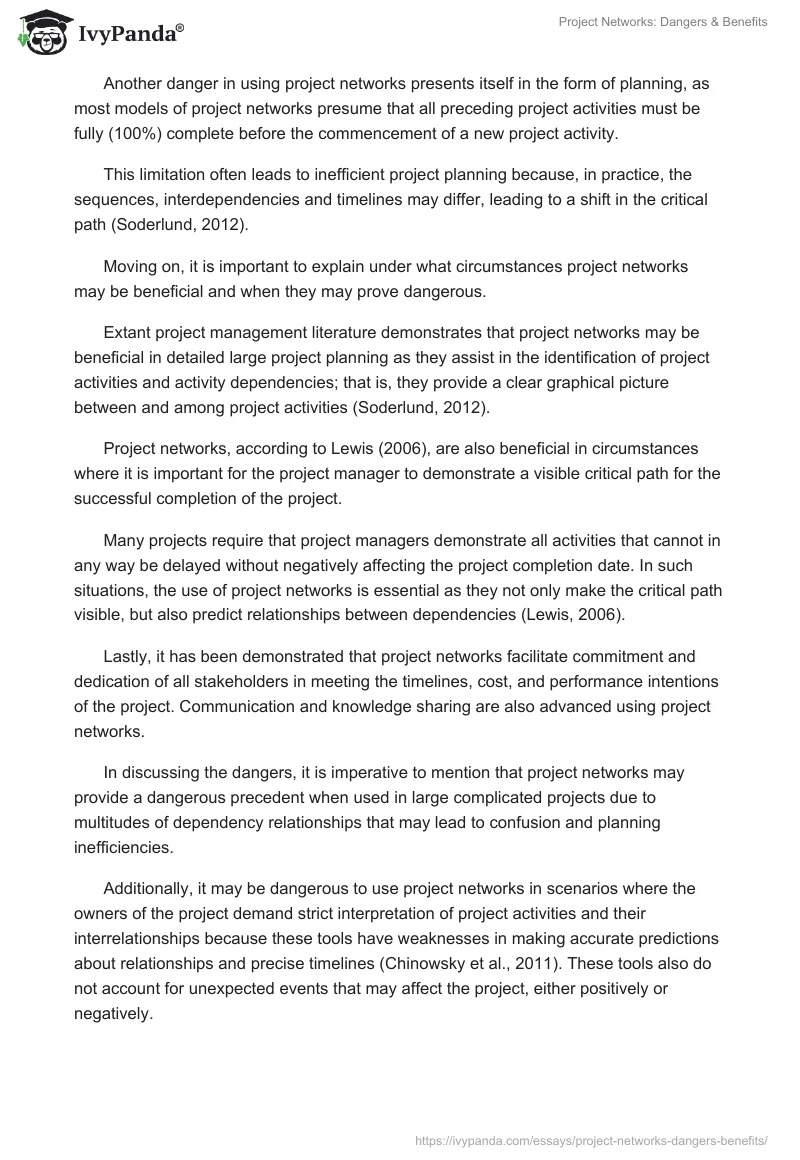Within the project management domain, project networks are fundamental tools used to illustrate the sequence in which a project’s terminal components are to be completed by constructing a network representation of the cardinal project activities and their dependencies.
Project networks, which are often constructed as graphs or flow charts, are important not only in understanding the types of activity dependencies and when they are utilized within the project management discourse, but also identifying the critical path in the project (Lewis, 2006). The present short paper aims at identifying and discussing some of the dangers and benefits of using project networks.
Although project managers often design project networks to assist them plan for the completion of important project activities, these tools act as a catalyst for unforeseen problems or dangers that may adversely affect project timelines (Chinowsky et al., 2011).
For instance, some project networks of very large projects may be extremely complicated and confusing, with hundreds or even thousands of project activities and dependency relationships, leading to difficulties not only in highlighting the critical path in the project, but also identifying the types of constraints that create activity sequences (Soderlund, 2012).
Additionally, project management literature demonstrates that project networks run the risk of prediction inaccuracies as they depend on the capacity to predict relationships and precise timeframes for a multiplicity of project activities, known as nodes.
Project management scholarship reveals that this prediction of precedence relationships using arrows (arcs) may be difficult for complicated projects involving many activities and suppliers (Soderlund, 2012), and also fails to make provisions for unexpected events that may present within the lifecycle of the project (Lewis, 2006).
Another danger in using project networks presents itself in the form of planning, as most models of project networks presume that all preceding project activities must be fully (100%) complete before the commencement of a new project activity.
This limitation often leads to inefficient project planning because, in practice, the sequences, interdependencies and timelines may differ, leading to a shift in the critical path (Soderlund, 2012).
Moving on, it is important to explain under what circumstances project networks may be beneficial and when they may prove dangerous.
Extant project management literature demonstrates that project networks may be beneficial in detailed large project planning as they assist in the identification of project activities and activity dependencies; that is, they provide a clear graphical picture between and among project activities (Soderlund, 2012).
Project networks, according to Lewis (2006), are also beneficial in circumstances where it is important for the project manager to demonstrate a visible critical path for the successful completion of the project.
Many projects require that project managers demonstrate all activities that cannot in any way be delayed without negatively affecting the project completion date. In such situations, the use of project networks is essential as they not only make the critical path visible, but also predict relationships between dependencies (Lewis, 2006).
Lastly, it has been demonstrated that project networks facilitate commitment and dedication of all stakeholders in meeting the timelines, cost, and performance intentions of the project. Communication and knowledge sharing are also advanced using project networks.
In discussing the dangers, it is imperative to mention that project networks may provide a dangerous precedent when used in large complicated projects due to multitudes of dependency relationships that may lead to confusion and planning inefficiencies.
Additionally, it may be dangerous to use project networks in scenarios where the owners of the project demand strict interpretation of project activities and their interrelationships because these tools have weaknesses in making accurate predictions about relationships and precise timelines (Chinowsky et al., 2011). These tools also do not account for unexpected events that may affect the project, either positively or negatively.
References
Chinowsky, P., Taylor, J.E., & Di Marco, M. (2011). Project network interdependency alignment: New approach to assessing project effectiveness. Journal of Management Engineering, 27(3), 170-178.
Lewis, J.P. (2006). Fundamentals of project management (3rd ed.). New York, NY: AMACOM.
Soderlund, J. (2012). Project management, interdependencies, and time insights from managing larger systems by Sayles and Chandler. International Journal of Managing Projects in Business, 5(4), 617-633.


